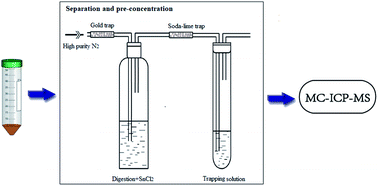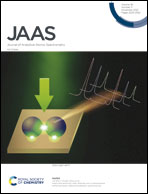Separation of methylmercury from biological samples for stable isotopic analysis†
Abstract
Mercury (Hg) isotopic geochemistry is a powerful tool for understanding the sources and geochemical processes of Hg in natural environments. Current Hg isotopic analysis mainly focuses on total Hg in natural samples, whereas the isotopic composition of methylmercury (MeHg), which is a neurotoxin to humans and wildlife, remains poorly understood. In this study, we developed an offline two-round purging-trapping method for MeHg separation from biological samples. This method enables high efficiency of MeHg separation and high precision analysis of MeHg in environmental samples. MeHg standard solution spiked with inorganic Hg (IHg) standard solution yielded MeHg recoveries of 94–112% (103 ± 4%, n = 9) and no obvious MeHg isotopic fractionation was observed. Analysis of various biological reference materials (CRMs) using this new method showed acceptable MeHg recoveries of 90–119% (101 ± 8%, n = 18). The measured MeHg isotopic composition for the CRMs using the new method agreed well with the values in the literature and with much lower uncertainties (0.02–0.15‰, 2SD) compared with GC or HPLC separation methods. This new method yields similar accuracy and uncertainty to the available toluene extraction method. Therefore, the new method provides another reliable and efficient method for MeHg isotopic analysis, which should be useful to the Hg isotope research community.



 Please wait while we load your content...
Please wait while we load your content...